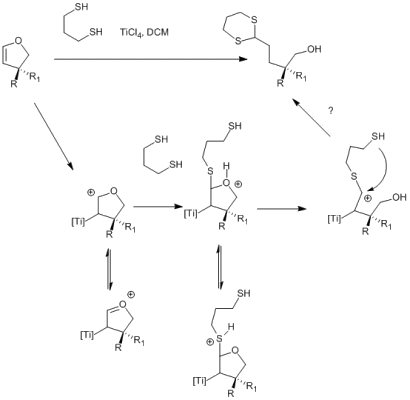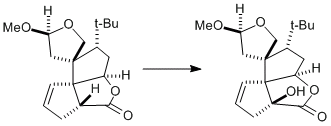

Dan_Ny
Senior Members-
Posts
64 -
Joined
-
Last visited
Dan_Ny's Achievements

Meson (3/13)
2
Reputation
-

mesomeric and inductive effect
Dan_Ny replied to Dr_fatima A. El_shazly's topic in Organic Chemistry
Yo inductive effects are through-bond polarizations which are due to different electronegatvity of the two partners of a sigma bond. For example if you have a hydroxyl-group in a carbon framework, the binding electrons between C and OH will be "drawn" to the side of the hydroxy-oxygen. mesomeric effects are polarizations vial pi-bonds. pi bonds arise from the conjugation of p orbitals. So if you have a carbonyl group, for example, in that group the oxygen draws electrons as well as by an inductive effect (sigma bond) as by an mesomeric effect (pi bond) from the carbon atom in the carbonyl. the pi-conjugation in aromatic compounds functions (as another example of a mesomeric effect) as a "pi-relay" for electron-withdrawal via pi bonds. yeah but you will find much better explanations of this on wikipedia: http://en.wikipedia.org/wiki/Mesomeric_effect Yours -
It depends to what you refer. My first guess would be that you mean the stabilization of an (carb-) anion or cation. In general, though, mesomeric effect (pi-conjugation, transfer of electron density via the p- or pi- orbitals) overrides hyperconjugation (transfer of electron density from a covalent (and coplanar) bond into a empty p-orbital next to it or reverse. Hm. I am not 100% sure about that myself. When you have a carbanion and a coplanar C-H covalent bond next to it, does the anionic electron pair transfer electron density into that covalent bond? Or does this only work reverse, in the case of a cation? Yeah anyway. In short: pi-conjugation ("mesomeric conjugation") overrides hyperconjugation.
-

Role of TiCl4 in ring-opening/thioacetal formation
Dan_Ny replied to Dan_Ny's topic in Organic Chemistry
I totally and completely agree, titanium activatin an alkene does not sound right at all for me. But as long as you invent a good explanation... By the way, what exactly is the role of TiCl4 in metathesis reactions (sorry!!! I just "love 'em", like you know very well). What does it do to the first gen. grubbs? I might ask a few questions about the diels alder as a ring-closing element in synthesis later. What we have so far is: Macrolactonization, RCM, DA. What else is there? I just want to know the best ways to close a ring... -

Role of TiCl4 in ring-opening/thioacetal formation
Dan_Ny replied to Dan_Ny's topic in Organic Chemistry
Titanium is a reagent in this reaction and used as in excess... Not a catalyst. -

Role of TiCl4 in ring-opening/thioacetal formation
Dan_Ny replied to Dan_Ny's topic in Organic Chemistry
6 columns. Well, i hope you are doing small-scale reactions. You were right, I had one carbon too much, apologies... I have a new idea: So, in my opinion, substitution at an olefin does not exist. to bypass that, what do you think about activation of the double bond by the lewis acid, attack of the first thiol group and subsequent coordination of the oxygen and attack of the second thiol group? does that sound reasonable? Yeah, that would be explained by a olefin then oxygen activation; first a protic acid for the double bond and then an oxophile. what do you think? -

Role of TiCl4 in ring-opening/thioacetal formation
Dan_Ny replied to Dan_Ny's topic in Organic Chemistry
5 columns, hm? i hope you have access to a biotage (auto-column), then... You're right, Horza, what I proposed does not make too much sense. But how does the Titanium activate the vinylether? I'll look through the web later, perhaps wikipedia has something to say about it... -

Role of TiCl4 in ring-opening/thioacetal formation
Dan_Ny replied to Dan_Ny's topic in Organic Chemistry
Wow, thanks But this is not a metathesis reaction (my mistake, i shouldn't have called it ring-opening) -
I think we aren't even contradicting each other. When I said "A suspension is material suspended in a solvent in which it is not soluble.", that also applied for oversaturated solutions. Your excess of sugar, for example, is not soluble in the solution over it due to the high amount of sugar already in it. In the end, you can have a solution and a suspension at the same time (given mechanical force, e.g. stirring). What i suggest, however, is a careful use of both these words.
-
we should make definitions that make sense, i suggest. a solution is a solution if a significant part of a solid is dissolved in it. a part that has chemical relevance in the sense that a reaction is meant to happen with the soluted stuff. you can always try to hairsplit any argument, but from my point of view there should be a definition and this definition should make sense and have a practical relevance.
-
I have no idea about the mechanism of this reaction. Anybody could help? Since according to wikipedia, TiCl4 is a Lewis, acid, we could propose this mechanism: One drawback is, that i would not see how we get rid of the Titanium lewis-acid in the last step to furnish a reduced product. (Reductive workup perhaps?) The second thing is that wikipedia states, that TiCl4 is an oxophiliic lewis acid. So, coordination to the oxygen in the first step in order to activate the carbon... The problem is, that lewsi activation of vinly ethers activate the carbon beta to the ether oxygen and the thiol would attack at the wrong carbon. Plus, we need double activation to get both sulfurs at the carbon. Does anybody have an idea?
-
In my opinion, most methods to remove elemental silver from you hands would involve removal of the hand in question, too. I would wash them very often and it'll wear off after a time...
-
dude this is totally INsufficient man. A suspension is material suspended in a solvent in which it is not soluble. The case we were talking about, my man, is an oversaturated solution (like the brine on you bench an oversaturated solution is). Because the solid IS soluble in it. And not a suspension, where the solid is'nt. And a not oversaturated solution is that what you would call a solution. My pleasure.
-
By the way, in the next step, he oxidates an enolate to a alpha-hydroxylactone under the use of an oxaziridine (an "electrophilic hydroxygroup" so to say) (see below). Enolates are known for the fact that they are configurationally unstable at the alpha-carbon. Why does he get complete stereoselectivity for hydroxylation? The next step is something I don't completely understand. Is this a CH-activation? In a paper from 1984? But it seems to be- What is the mechanism of it? A radical-mechanism? Hypervalent?
-
Dude. It's absolutely NOT save to just demand the scanned picture of an ID. Actually, I think there are also laws against private circulation of cyanides. And there have been an awful lot of cases pf people killing themselves with cyanides. I think this topic should be deleted.





